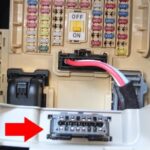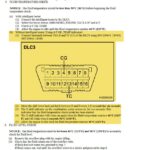Experiencing issues with your diesel particulate filter (DPF)? A clogged DPF can lead to reduced engine performance and warning lights on your dashboard. If you’re encountering error codes related to DPF regeneration, such as the P245800 code indicating a Particulate Filter Regeneration Duration issue, you might be considering a forced DPF regeneration. This process, initiated using an OBD2 scanner, can help clear soot buildup and restore your vehicle’s performance.
Forced DPF regeneration via an OBD2 device is a procedure that commands your car’s engine control unit (ECU) to initiate a regeneration cycle, even if the conditions for automatic regeneration aren’t met. This can be particularly useful when your DPF is heavily clogged, preventing normal driving regeneration.
Understanding DPF Regeneration and When Forced Regeneration is Needed
The DPF is crucial in modern diesel vehicles, trapping harmful soot particles from exhaust gases. Regeneration is the process of burning off this accumulated soot at high temperatures, usually happening automatically when driving at highway speeds. However, short trips and city driving can prevent the DPF from reaching the necessary temperatures for self-cleaning, leading to soot buildup.
When soot levels become too high, your car may trigger a warning light and potentially enter limp mode. While driving at higher speeds for an extended period might initiate automatic regeneration, in some cases, particularly with significant blockages, a forced regeneration using an OBD2 scanner becomes necessary.
Using an OBD2 Scanner for Forced DPF Regeneration: A Step-by-Step Approach
To perform a forced DPF regeneration, you’ll need an OBD2 scanner capable of advanced functions, including basic settings and service procedures. Tools like OBDeleven, VCDS (VAG-COM), and professional-grade scan tools often offer this functionality.
Here’s a general guide based on user experiences, but always consult your vehicle’s repair manual and your OBD2 scanner’s instructions for specific procedures:
- Connect your OBD2 scanner to your vehicle’s diagnostic port.
- Turn on the ignition but do not start the engine. Ensure all electrical consumers (lights, radio, HVAC) are turned off to minimize electrical load.
- Navigate to the “Service” or “Basic Settings” menu in your OBD2 scanner. The exact menu names will vary depending on your tool.
- Look for options related to “DPF Regeneration,” “Particle Filter Regeneration,” or “Service Regeneration of Particulate Filter.”
- Select the “Forced Regeneration” or “Service Regeneration” option. Some scanners may offer options like “Service regeneration of particulate filter *while driving*” and “Service regeneration of particle filter.” User reports suggest activating “Service regeneration of particulate filter *while driving*” first, followed by “Service regeneration of particle filter” might be effective in certain cases.
- Follow the on-screen prompts and instructions provided by your OBD2 scanner. This usually involves starting the engine and keeping the engine speed at a specific RPM (e.g., around 1500 RPM) for a set duration. Some systems may require you to press and hold both the accelerator and brake pedals simultaneously during the process, as reported by users.
- Monitor the regeneration process via your OBD2 scanner if possible. The scanner may display parameters like DPF soot levels or regeneration status. You might also hear changes in engine sound and feel increased heat from the exhaust system during regeneration.
- Allow the regeneration process to complete fully. Do not interrupt the process, even if it takes 20-30 minutes or longer. The engine RPM may remain elevated even after the regeneration cycle appears complete, before eventually returning to idle speed.
- Once the regeneration is finished, perform a fault code scan with your OBD2 scanner and clear any DPF-related error codes that remain.
Important Considerations and Precautions:
- Safety First: Forced DPF regeneration generates very high temperatures in the exhaust system. Ensure the vehicle is parked outdoors in a well-ventilated area, away from flammable materials, and that there is no risk of fire.
- Vehicle Specific Procedures: The exact steps and menu options can vary significantly between vehicle makes and models, and OBD2 scanner brands. Always refer to your vehicle’s repair manual and your OBD2 scanner’s user guide for precise instructions.
- Underlying Issues: Forced regeneration is a temporary solution. If your DPF is frequently clogging, it indicates an underlying issue, such as faulty sensors, engine problems causing excessive soot production, or driving habits unsuitable for diesel vehicles. Address these root causes to prevent recurring DPF problems.
- Professional Assistance: If you are unsure about performing a forced DPF regeneration or if the process fails, consult a qualified automotive technician. Incorrect procedures can potentially damage your vehicle.
Conclusion
Forced DPF regeneration using an OBD2 scanner can be a helpful DIY solution for clearing a clogged diesel particulate filter and resolving related error codes. By understanding the process, using the correct tools, and following safety precautions, you can potentially restore your vehicle’s performance. However, remember to address the underlying causes of DPF clogging and seek professional help when needed.

